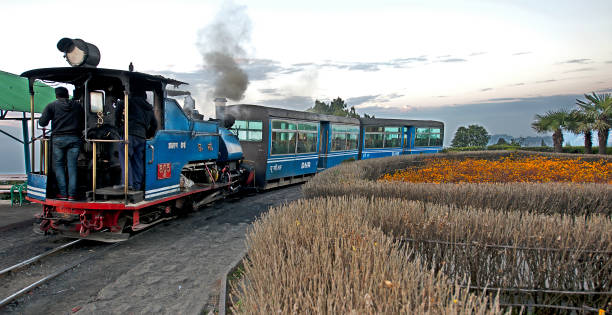PART – III
India is a vibrant and exciting tourist destination that offers something for everyone. From the majestic Himalayas in the north to the stunning beaches of the south, India is a land of incredible beauty and contrasts. From the alluring culture and history of the ancient cities like Delhi, Agra and Varanasi to the modern architecture and lifestyle of Mumbai and Bangalore, India is a country that will keep you coming back for more. With its diverse and exotic wildlife, lush landscapes, and variety of culinary delights, India is truly a paradise for tourists. Whether you want to relax in the sun on a Goan beach or explore the country’s many national parks and monuments, India is a great place to visit.
Some more exciting destinations you must explore in India:
9. Darjeeling:

Darjeeling is a serene hill station located in the Indian state of West Bengal. It is situated in the foothills of the Himalayas and is surrounded by lush green tea plantations, offering breathtaking views of the snow-capped mountains. It is known for its colonial architecture, vibrant culture and serene atmosphere. The most popular attractions in Darjeeling include the Tiger Hill, where visitors can witness a spectacular sunrise over the majestic Kanchenjunga, explore many monasteries that dot the landscape, and take a ride on the legendary the Darjeeling Himalayan Railway.
Popular tourist attractions also include the Ghoom Monastery, and the Himalayan Mountaineering Institute. Tourists can also visit the tea plantations and factories, and explore the local markets for traditional handicrafts.Other attractions include the lush tea gardens, vibrant markets, and adventure activities such as hiking, mountain biking, and paragliding.
Darjeeling is the perfect destination for a peaceful getaway or an adventurous holiday. It has something to offer for everyone, from families to solo travelers. Visitors can explore the many attractions and indulge in the local cuisine, explore the culture and witness the stunning views of the Himalayas.
Darjeeling is a culinary paradise, with a wide variety of local dishes that reflect the region’s diverse cultures. Some of the most popular dishes include momos (steamed dumplings), thukpa (noodle soup), chowmein (fried noodles), and kinema (fermented soybeans). Visitors can also try traditional Tibetan dishes such as tsampa (roasted barley flour) and thenthuk (noodle soup). For those with a sweet tooth, there is plenty to choose from. Popular desserts include the traditional sandesh (milk-based sweet), gulab jamun (deep-fried dumpling soaked in sugar syrup), and the local favorite, kheer (rice pudding).
For those looking for something more substantial, there are plenty of local restaurants serving up delicious dishes such as aloo gobi (potato and cauliflower curry), chowmein, and momos. Visitors can also explore the local street food, which includes momos, samosas, noodle dishes, and much more. No matter what your taste, Darjeeling has something for everyone.
10. Rishikesh:

Rishikesh is a popular tourist destination located in the Northern Indian state of Uttarakhand. It is known as the “Yoga Capital of the World” and is a hub for spiritual seekers and adventurers alike. The city is situated on the banks of the holy Ganges River and is surrounded by lush green forests, making it an ideal destination for nature lovers. It is also home to numerous ashrams and temples, making it a great place to explore India’s spiritual and cultural heritage.
Popular activities in Rishikesh include white-water rafting, camping, trekking, yoga, and meditation. Tourists can also take part in yoga and meditation classes, visit nearby wildlife reserves such as the Rajaji National Park, and explore ancient caves such as the Vashishta Gufa
Rishikesh is situated in the foothills of the Himalayas, on the banks of the holy Ganges River. The city is the gateway to the Garhwal region of Uttarakhand, and is known for its spiritual and cultural heritage. It is an important pilgrimage site for Hindus, and is home to many ancient temples and ashrams.
The main attractions in Rishikesh are the Lakshman Jhula, a suspension bridge that spans the Ganges, the Ram Jhula, a bridge over the river, the Neelkanth Mahadev temple, dedicated to Lord Shiva, the Kunjapuri Temple, the Bharat Mandir and the Triveni Ghat. Other popular activities in Rishikesh include white-water rafting, camping, trekking, yoga, and meditation.
Rishikesh is also a great destination for adventure seekers, with a range of activities like bungee jumping, rappelling, kayaking, and mountain biking. The city is also home to many cafes and restaurants, offering a variety of cuisines to suit all tastes.
Rishikesh is a great place to experience traditional Indian culture and heritage. The city is home to many traditional Indian festivals, including the Maha Kumbh Mela, the International Yoga Festival, and the International Adventure Festival. These festivals attract visitors from all over the world, and offer a great opportunity to mingle with locals and learn more about Indian culture.
Rishikesh is also known for its vibrant nightlife, with many bars, pubs, and clubs offering a range of entertainment options. It is also home to many shopping destinations, such as the Ganges Shopping Complex, the Rishikesh Mall, the Lakshman Jhula Market and explore the local markets for traditional handicrafts.
Rishikesh is a great tourist destination, offering something for everyone. Whether you’re looking for spiritual enlightenment, adventure, or traditional Indian culture, Rishikesh has it all.
In conclusion, Rishikesh is a wonderful destination for spiritual seekers, adventurers, and culture enthusiasts alike. From ancient temples and ashrams to modern shopping malls and nightlife, there is something for everyone in Rishikesh. With its unique mix of spiritual and cultural heritage, natural beauty, and modern amenities, Rishikesh is an ideal destination for a memorable holiday.
11. Assam:

Assam is a northeastern state in India, known for its tea plantations, wildlife sanctuaries, and vibrant culture. It is home to the Brahmaputra River, one of the longest rivers in India, and the Kaziranga National Park, a World Heritage Site. In terms of culture, Assam is known for its traditional hand-loom textiles, its vibrant Bihu festival, and its various tribal cultures.
Assam is also known for its many wildlife sanctuaries, including the Manas National Park, Orang National Park, and Nameri National Park. It is also home to numerous temples, including the Umananda Temple, the Kamakhya Temple, and the Madan Kamdev temple. Assam is a popular tourist destination for its many attractions, from its tea plantations to its wildlife sanctuaries and vibrant culture.
Kaziranga National Park: Located in the Golaghat and Nagaon districts of Assam, Kaziranga National Park is a UNESCO World Heritage Site and one of India’s most popular tourist destinations. It is home to two-thirds of the world’s population of the Great Indian one horned rhinoceros, as well as numerous other species of mammals like elephants, buffaloes, tigers, leopards, reptiles, and birds. The park also offers numerous safaris, birdwatching, and guided tours.
Majuli Island: Majuli Island is the world’s largest river island situated in the Brahmaputra River. It is known for its unique culture and lifestyle, and is a popular destination for tourists looking to experience the traditional Assamese culture. Visitors can explore the various tribal villages, local markets, and monasteries on the island.
Umananda Temple: Umananda Temple is one of the oldest and most sacred Hindu temples in Assam and is situated on the Peacock Island in the middle of the Brahmaputra River. The temple is dedicated to Lord Shiva and is a popular pilgrimage site.
Sualkuchi: Sualkuchi is a traditional weaving village located on the banks of the Brahmaputra River. It continue writing is known for its beautiful silk sarees, which are crafted using traditional weaves and dyes. Visitors can explore the weaving process and purchase traditional Assamese silk sarees from the village.
Madan Kamdev: Madan Kamdev is an ancient temple complex situated near Guwahati. It is known for its intricate carvings and sculptures and is a popular pilgrimage site for Hindus.
Kamakhya Temple: The Kamakhya Temple is one of the most important Hindu pilgrimage sites in India. It is situated on the Nilachal Hill in Guwahati and is dedicated to the Goddess Kamakhya. It is a popular destination for devotees and tourists alike.
Assam State Zoo: Assam State Zoo cum Botanical Garden established in 1957 occupying an area of 175 hectares is one of the largest and oldest zoo of its kind in India. It is the home of about 895 animals, birds and reptiles among 113 species from all around the World.It is also known as “Green Lungs” of Guwahati City.
Manas National Park: Manas National Park is a UNESCO World Heritage Site and a renowned wildlife sanctuary located in the foothills of the Himalayas. The park is home to numerous endangered species of animals, including the Bengal tiger, Indian elephant, and the pygmy hog. Visitors can explore the park on safaris and witness the diverse wildlife and flora.
Orang National Park: Orang National Park is located in the Darrang and Sonitpur districts of Assam. It is known for its large population of the Continue writing endangered one horned rhinoceros, as well as tigers, elephants, and numerous species of birds. Visitors can explore the park on safaris and witness the incredible wildlife.
Nameri National Park: Nameri National Park is a popular wildlife sanctuary located in the Sonitpur district of Assam. It is home to numerous species of mammals, birds, and reptiles, including the endangered white-winged wood duck, the great Indian hornbill, and the Himalayan black bear. Visitors can explore the park on safaris and guided tours.
Gibbon Wildlife Sanctuary: Gibbon Wildlife Sanctuary is a popular wildlife sanctuary located in the Jorhat district of Assam. It is home to the endangered hoolock gibbon, as well as various species of birds and mammals. Visitors can explore the sanctuary on safaris and birdwatching tours.
Tezpur: Tezpur is a popular tourist destination located in the Sonitpur district of Assam. It is known for its ancient temples, forts, and monuments, as well as its scenic beauty and numerous outdoor activities. Visitors can explore the town on sightseeing tours and visit the numerous attractions in and around Tezpur.
Haflong Hill Station: Haflong Hill Station is a popular hill station situated in the Haflong town of Assam. It is known for its scenic beauty and numerous outdoor activities, such as trekking and boating. Visitors can also explore the nearby tribal villages and experience the traditional culture of the region. Haflong Lake is a beautiful lake located in the Haflong town of Assam. It is a popular tourist destination due to its picturesque beauty and the various activities it offers, such as boating and fishing.
In conclusion, Assam is a unique and beautiful state in India that is full of fascinating attractions and experiences. From its wildlife sanctuaries and tea plantations to its vibrant culture and traditional hand-loom textiles, there is something for everyone in this beautiful state. Whether you’re looking for adventure or relaxation, Assam has something to offer every traveller.
Conclusion:
India is home to a range of affordable tourist destinations, offering a wide variety of attractions and activities. From the beaches of Goa to the hill stations of Shimla, Manali and Darjeeling, to the historical cities of Agra and Jaipur, to the backwaters of Alleppey and the spiritual town of Rishikesh, unique beauty and diversity of Assam there is something for everyone. India is a great destination for budget travellers looking to explore and experience the country’s rich culture and natural beauty.
India is also known for its vibrant festivals, delicious cuisines, and unique handicrafts, making it a perfect destination for travellers looking to get away from the hustle and bustle of everyday life. Whether you are looking for a beach holiday, a hill station getaway, or a spiritual journey, India offers a range of affordable tourist destinations that will leave you with lasting memories.
India also offers an array of accommodation options, from luxury resorts and hotels to budget guesthouses and homestays, ensuring that travellers of all budgets can find the perfect place to stay. With its diverse culture, stunning scenery, and friendly people, India is an ideal destination for affordable tourism.















































































